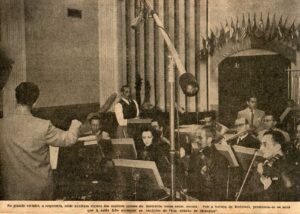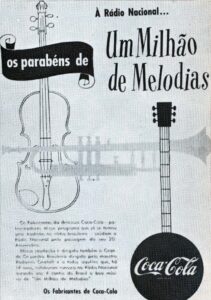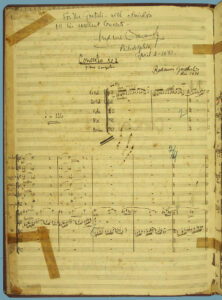- After the death of maestro Alexandre Gnattali, in 1942, his wife Adélia and their children, Aída, Alexandre and Maria Terezinha, left Porto Alegre and moved permanently to Rio de Janeiro.
- At 9:35 pm on January 6, Radio Nacional premiered the program
A Million Melodies
with the sponsorship of Coca-Cola Refrescos S.A. [1]. Radamés is invited to assume the musical direction of the program, acting as pianist, arranger and conductor of the orchestra. Initially created to launch the soft drink in Brazil, the program, hosted by José Mauro, has been on the air for 14 years. To meet the diversity of repertoire required by the new program, Radamés expands the house orchestra to the dimension of a symphony; he completes the woodwind, brass, saxophones, and bowed strings suits, and introduces the harp, celesta, and timpani. At the rhythmic-harmonic base, giving support to this symphonic mass, piano, percussion and a full choro regional [2].

Rehearsal for A Million Melodies.
Opening of the program Um Milhão de Melodias (Radamés Gnattali’s prefix)
- Pianist Arnaldo Estrela wins the Columbia Concerts and, as a prize, travels to the United States, where he performs with the orchestras of Chicago, Washington, and Philadelphia. In the repertoire, the Concerto No. 2 for piano and orchestra (1936), by Radamés Gnattali. In Philadelphia, conductor Eugene Ormandy, who conducted the concert, writes to Radamés at the top of the score: “For Mr. Gnattali, with admiration for this excellent concerto.”
- Radamés, who had worked for the Victor label since 1933, transferred to Continental (founded that same year) and recorded the choros Remixingand Assim é melhor, of his own authorship, with a saxophone quartet formed by Zacarias, Quincas, Coruja and Sandoval.
- Still this year, the Victor label releases Radamés’ choro Sad and Waltz Entardecerwith the Victor Typical Orchestra.
- Radamés composes:
- Canadiana para grande orquestra – on Canadian folklore themes, in honor of his friend Jan Zach, a Canadian painter.
- Quartet No. 2 for 2 violins, viola and cello – dedicated to Mina, nickname of Vera, his first wife.
- The guitarist Turíbio Santos (Turíbio Soares Santos) is born in São Luiz (MA), to whom Radamés dedicates the first of Studies for Guitar (1967), a Brasiliana no. 13 (1983 ) and the Little suite ( 1985).
- Rachmaninoff (Sergei Vasilievich Rachmaninoff), whom Radamés admired as one of the three greatest composers of the 20th century, along with Ravel and Béla Bartók, dies in the USA
- The premiere, in Rio de Janeiro, of the play Vestido de Noiva, by Nelson Rodrigues, a milestone in the history of modern Brazilian theater.
- The government promulgates the Consolidation of Labor Laws (CLT), which regulated relations between employers and employees.








